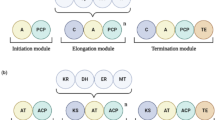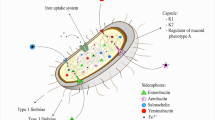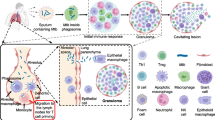Abstract
Iron (Fe) homeostasis control is important for both pathogen and the host. During infection, the host reduces the access of microorganisms to iron, however, studies have shown that virulent pathogens are capable to sequester Fe from host proteins, and establish the infection. M. abscessus subsp. massiliense (Mycma), that is resistant to most drugs used against tuberculosis, was responsible for outbreaks around the world showing increased virulence when compared to other rapidly growing mycobacteria. The goal of this study was to determine whether Mycma produce siderophores and if the mycma_1113 gene expression, a putative homolog of M. tuberculosis mbtB gene located in the mbt gene cluster, is related to the synthesis of these molecules. For that, the effect of different iron concentrations on the growth of Mycma, the expression of mycma_1113 gene, and the production of siderophores was evaluated in vitro and in vivo. It is shown that Mycma produce siderophores under iron deprivation conditions and mycma_1113 gene expression was influenced by iron availability. The mycma_1113 gene expression was also increased after macrophage or in vivo infection indicating that mycobactin synthesis by Mycma could participate in the Fe sequestration from the host during infection. In conclusion, we show that Mycma produces siderophores under iron deprivation conditions and that the mycma_1113 gene is involved in this process, furthermore, this gene expression is induced during infection.






Similar content being viewed by others
References
Lee MR, Sheng WH, Hung CC, Yu CJ, Lee LN, Hsueh PR (2015) Mycobacterium abscessus complex infections in humans. Emerg Infect Dis 21:1638–1646. https://doi.org/10.3201/2109.141634
Tettelin H, Davidson RM, Agrawal S, Aitken ML, Shallom S, Hasan NA, Strong M, de Moura VC, De Groote MA, Duarte RS, Hine E, Parankush S, Su Q, Daugherty SC, Fraser CM, Brown-Elliott BA, Wallace RJ, Jr, Holland SM, Sampaio EP, Olivier KN, Jackson M, Zelazny AM (2014) High-level relatedness among Mycobacterium abscessus subsp. massiliense strains from widely separated outbreaks. Emerg Infect Dis 20:364–371. https://doi.org/10.3201/eid2003.131106
Bryant JM, Grogono DM, Rodriguez-Rincon D, Everall I, Brown KP, Moreno P, Verma D, Hill E, Drijkoningen J, Gilligan P, Esther CR, Noone PG, Giddings O, Bell SC, Thomson R, Wainwright CE, Coulter C, Pandey S, Wood ME, Stockwell RE, Ramsay KA, Sherrard LJ, Kidd TJ, Jabbour N, Johnson GR, Knibbs LD, Morawska L, Sly PD, Jones A, Bilton D, Laurenson I, Ruddy M, Bourke S, Bowler IC, Chapman SJ, Clayton A, Cullen M, Dempsey O, Denton M, Desai M, Drew RJ, Edenborough F, Evans J, Folb J, Daniels T, Humphrey H, Isalska B, Jensen-Fangel S, Jonsson B, Jones AM, Katzenstein TL, Lillebaek T, MacGregor G, Mayell S, Millar M, Modha D, Nash EF, O'Brien C, O'Brien D, Ohri C, Pao CS, Peckham D, Perrin F, Perry A, Pressler T, Prtak L, Qvist T, Robb A, Rodgers H, Schaffer K, Shafi N, van Ingen J, Walshaw M, Watson D, West N, Whitehouse J, Haworth CS, Harris SR, Ordway D, Parkhill J, Floto RA (2016) Emergence and spread of a human-transmissible multidrug-resistant nontuberculous mycobacterium. Science 354:751–757. https://doi.org/10.1126/science.aaf8156
Nessar R, Cambau E, Reyrat JM, Murray A, Gicquel B (2012) Mycobacterium abscessus: a new antibiotic nightmare. J Antimicrob Chemother 67:810–818. https://doi.org/10.1093/jac/dkr578
Rodriguez GM, Smith I (2003) Mechanisms of iron regulation in mycobacteria: role in physiology and virulence. Mol Microbiol 47:1485–1494
Ratledge C (2004) Iron, mycobacteria and tuberculosis. Tuberculosis (Edinb) 84:110–130
Rodriguez GM (2006) Control of iron metabolism in Mycobacterium tuberculosis. Trends Microbiol 14:320–327. https://doi.org/10.1016/j.tim.2006.05.006
Guerinot ML (1994) Microbial iron transport. Annu Rev Microbiol 48:743–772. https://doi.org/10.1146/annurev.mi.48.100194.003523
McMahon MD, Rush JS, Thomas MG (2012) Analyses of MbtB, MbtE, and MbtF suggest revisions to the mycobactin biosynthesis pathway in Mycobacterium tuberculosis. J Bacteriol 194:2809–2818. https://doi.org/10.1128/JB.00088-12
Patel K, Butala S, Khan T, Suvarna V, Sherje A, Dravyakar B (2018) Mycobacterial siderophore: a review on chemistry and biology of siderophore and its potential as a target for tuberculosis. Eur J Med Chem 157:783–790. https://doi.org/10.1016/j.ejmech.2018.08.030
Quadri LE, Sello J, Keating TA, Weinreb PH, Walsh CT (1998) Identification of a Mycobacterium tuberculosis gene cluster encoding the biosynthetic enzymes for assembly of the virulence-conferring siderophore mycobactin. Chem Biol 5:631–645
Krithika R, Marathe U, Saxena P, Ansari MZ, Mohanty D, Gokhale RS (2006) A genetic locus required for iron acquisition in Mycobacterium tuberculosis. Proc Natl Acad Sci USA 103:2069–2074. https://doi.org/10.1073/pnas.0507924103
Schnappinger D, Ehrt S, Voskuil MI, Liu Y, Mangan JA, Monahan IM, Dolganov G, Efron B, Butcher PD, Nathan C, Schoolnik GK (2003) Transcriptional adaptation of Mycobacterium tuberculosis within macrophages: insights into the phagosomal environment. J Exp Med 198:693–704. https://doi.org/10.1084/jem.20030846
Madigan CA, Cheng TY, Layre E, Young DC, McConnell MJ, Debono CA, Murry JP, Wei JR, Barry CE 3rd, Rodriguez GM, Matsunaga I, Rubin EJ, Moody DB (2012) Lipidomic discovery of deoxysiderophores reveals a revised mycobactin biosynthesis pathway in Mycobacterium tuberculosis. Proc Natl Acad Sci USA 109:1257–1262. https://doi.org/10.1073/pnas.1109958109
Reddy PV, Puri RV, Chauhan P, Kar R, Rohilla A, Khera A, Tyagi AK (2013) Disruption of mycobactin biosynthesis leads to attenuation of Mycobacterium tuberculosis for growth and virulence. J Infect Dis 208:1255–1265. https://doi.org/10.1093/infdis/jit250
Timm J, Post FA, Bekker LG, Walther GB, Wainwright HC, Manganelli R, Chan WT, Tsenova L, Gold B, Smith I, Kaplan G, McKinney JD (2003) Differential expression of iron-, carbon-, and oxygen-responsive mycobacterial genes in the lungs of chronically infected mice and tuberculosis patients. Proc Natl Acad Sci USA 100:14321–14326. https://doi.org/10.1073/pnas.2436197100
Dubnau E, Chan J, Mohan VP, Smith I (2005) responses of Mycobacterium tuberculosis to growth in the mouse lung. Infect Immun 73:3754–3757. https://doi.org/10.1128/IAI.73.6.3754-3757.2005
De Voss JJ, Rutter K, Schroeder BG, Su H, Zhu Y, Barry CE 3rd (2000) The salicylate-derived mycobactin siderophores of Mycobacterium tuberculosis are essential for growth in macrophages. Proc Natl Acad Sci USA 97:1252–1257
Martins de Sousa E, Bonfim de Bortoli F, Amaral EP, Batista AC, Liberman Kipnis T, Marques Cardoso A, Kipnis A, Junqueira-Kipnis AP (2010) Acute immune response to Mycobacterium massiliense in C57BL/6 and BALB/c mice. Infect Immun 78:1571–1581. https://doi.org/10.1128/iai.00731-09
Medjahed H, Gaillard JL, Reyrat JM (2010) Mycobacterium abscessus: a new player in the mycobacterial field. Trends Microbiol 18:117–123. https://doi.org/10.1016/j.tim.2009.12.007
Abdalla MY, Switzer BL, Goss CH, Aitken ML, Singh PK, Britigan BE (2015) Gallium compounds exhibit potential as new therapeutic agents against Mycobacterium abscessus. Antimicrob Agents Chemother 59:4826–4834. https://doi.org/10.1128/aac.00331-15
Menegói G, Raiol T, Oliveira JVdA, Sandes EFdO, Melo ACMAd, Maranhão AQ, Silva-Pereira I, Bocca AL, Junqueira-Kipnis AP, Walter MEMT, Kipnis A, Brígido MdM (2013) A pipeline to characterize virulence factors in Mycobacterium massiliense genome. In: Advances in Bioinformatics and Computational Biology Lecture Notes in Computer Science. https://doi.org/10.1007/978-3-319-02624-4_19
Chavadi SS, Stirrett KL, Edupuganti UR, Vergnolle O, Sadhanandan G, Marchiano E, Martin C, Qiu WG, Soll CE, Quadri LE (2011) Mutational and phylogenetic analyses of the mycobacterial mbt gene cluster. J Bacteriol 193:5905–5913. https://doi.org/10.1128/JB.05811-11
Raiol T, Ribeiro GM, Maranhao AQ, Bocca AL, Silva-Pereira I, Junqueira-Kipnis AP, Brigido Mde M, Kipnis A (2012) Complete genome sequence of Mycobacterium massiliense. J Bacteriol 194:5455. https://doi.org/10.1128/JB.01219-12
Oliveira FM, Da Costa AC, Procopio VO, Garcia W, Araújo JN, Da Silva RA, Junqueira-Kipnis AP, Kipnis A (2018) Mycobacterium abscessus subsp. massiliense mycma_0076 and mycma_0077 genes code for ferritins that are modulated by iron concentration. Front Microbiol 9:1072. https://doi.org/10.3389/fmicb.2018.01072
Perez-Miranda S, Cabirol N, George-Tellez R, Zamudio-Rivera LS, Fernandez FJ (2007) O-CAS, a fast and universal method for siderophore detection. J Microbiol Methods 70:127–131. https://doi.org/10.1016/j.mimet.2007.03.023
Gao Y, Wang N, Zhang Y, Ma Z, Guan P, Ma J, Zhang Y, Zhang X, Wang J, Zhang J, Chu L (2013) Mechanism of protective effects of Danshen against iron overload-induced injury in mice. J Ethnopharmacol 145:254–260. https://doi.org/10.1016/j.jep.2012.10.060
Gaspar EB, Sakai YI, Gaspari ED (2014) A mouse air pouch model for evaluating the immune response to Taenia crassiceps infection. Exp Parasitol 137:66–73. https://doi.org/10.1016/j.exppara.2013.12.005
Becker L, Liu NC, Averill MM, Yuan W, Pamir N, Peng Y, Irwin AD, Fu X, Bornfeldt KE, Heinecke JW (2012) Unique proteomic signatures distinguish macrophages and dendritic cells. PLoS ONE 7:e33297. https://doi.org/10.1371/journal.pone.0033297
da Costa AC, de Resende DP, Santos BPO, Zoccal KF, Faccioli LH, Kipnis A, Junqueira-Kipnis AP (2017) Modulation of macrophage responses by CMX, a fusion protein composed of Ag85c, MPT51, and HspX from Mycobacterium tuberculosis. Front Microbiol 8:623. https://doi.org/10.3389/fmicb.2017.00623
Sritharan M (2016) Iron homeostasis in Mycobacterium tuberculosis: mechanistic insights into siderophore-mediated iron uptake. J Bacteriol 198:2399–2409. https://doi.org/10.1128/JB.00359-16
Hood MI, Skaar EP (2012) Nutritional immunity: transition metals at the pathogen–host interface. Nat Rev Microbiol 10:525–537. https://doi.org/10.1038/nrmicro2836
Gold B, Rodriguez GM, Marras SA, Pentecost M, Smith I (2001) The Mycobacterium tuberculosis IdeR is a dual functional regulator that controls transcription of genes involved in iron acquisition, iron storage and survival in macrophages. Mol Microbiol 42:851–865
Pandey SD, Choudhury M, Sritharan M (2014) Transcriptional regulation of Mycobacterium tuberculosis hupB gene expression. Microbiology 160:1637–1647. https://doi.org/10.1099/mic.0.079640-0
Pandey SD, Choudhury M, Yousuf S, Wheeler PR, Gordon SV, Ranjan A, Sritharan M (2014) Iron-regulated protein HupB of Mycobacterium tuberculosis positively regulates siderophore biosynthesis and is essential for growth in macrophages. J Bacteriol 196:1853–1865. https://doi.org/10.1128/JB.01483-13
Neyrolles O, Wolschendorf F, Mitra A, Niederweis M (2015) Mycobacteria, metals, and the macrophage. Immunol Rev 264:249–263. https://doi.org/10.1111/imr.12265
Helguera-Repetto AC, Chacon-Salinas R, Cerna-Cortes JF, Rivera-Gutierrez S, Ortiz-Navarrete V, Estrada-Garcia I, Gonzalez-y-Merchand JA (2014) Differential macrophage response to slow- and fast-growing pathogenic mycobacteria. Biomed Res Int 2014:916521. https://doi.org/10.1155/2014/916521
Rodrigues PN, Gomes SS, Neves JV, Gomes-Pereira S, Correia-Neves M, Nunes-Alves C, Stolte J, Sanchez M, Appelberg R, Muckenthaler MU, Gomes MS (2011) Mycobacteria-induced anaemia revisited: a molecular approach reveals the involvement of NRAMP1 and lipocalin-2, but not of hepcidin. Immunobiology 216:1127–1134. https://doi.org/10.1016/j.imbio.2011.04.004
Zwilling BS, Kuhn DE, Wikoff L, Brown D, Lafuse W (1999) Role of iron in Nramp1-mediated inhibition of mycobacterial growth. Infect Immun 67:1386–1392
Acknowledgements
The authors are thankful for Dr. Célia Maria de Almeida Soares from University Federal of Goiás for her laboratory support with the experimental procedures for the O-CAS. The authors would like to thank FAPEG (20121026700048; 201310267000469), CNPq (307186/2013-0; 303675/2015-2), and CAPES Brazilian Agencies for the financial support.
Author information
Authors and Affiliations
Corresponding author
Additional information
Publisher’s Note
Springer Nature remains neutral with regard to jurisdictional claims in published maps and institutional affiliations.
Rights and permissions
About this article
Cite this article
de Oliveira, F.M., Corrêa, V.L., Corrêa, A.F. et al. The mycma_1113 Gene from Mycobacterium abscessus subsp. massiliense is Related to Siderophore Synthesis. Indian J Microbiol 59, 180–187 (2019). https://doi.org/10.1007/s12088-019-00788-z
Received:
Accepted:
Published:
Issue Date:
DOI: https://doi.org/10.1007/s12088-019-00788-z




